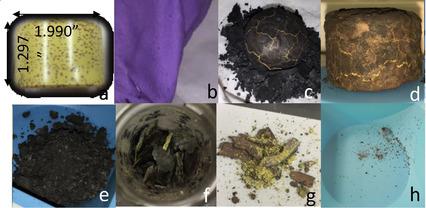当前位置:
X-MOL 学术
›
Propellants Explos. Pyrotech.
›
论文详情
Our official English website, www.x-mol.net, welcomes your
feedback! (Note: you will need to create a separate account there.)
LX-17 Thermal Decomposition-Characterization of Solid Residues from Cook-Off in a Small-Scale Vessel Under Confinement
Propellants, Explosives, Pyrotechnics ( IF 1.7 ) Pub Date : 2021-05-04 , DOI: 10.1002/prep.202100034 John G. Reynolds 1 , Nicolas K. Muetterties 1 , A. J. Nelson 1 , Harris E. Mason 1 , Jason S. Moore 1 , Keith R. Coffee 1 , Evan M. Kahl 1
Propellants, Explosives, Pyrotechnics ( IF 1.7 ) Pub Date : 2021-05-04 , DOI: 10.1002/prep.202100034 John G. Reynolds 1 , Nicolas K. Muetterties 1 , A. J. Nelson 1 , Harris E. Mason 1 , Jason S. Moore 1 , Keith R. Coffee 1 , Evan M. Kahl 1
Affiliation

|
Concerns surround whether insensitive (or any) energetic materials are more dangerous to handle when exposed to abnormal thermal environments. This study characterizes the residual material remaining after LX-17 (92.5 % 1,3,5-triamino 2,4,6-trinitro benzene (TATB) and 7.5 % Kel-F) is exposed to various thermal environments in a sealed small-scale vessel cook-off test reactor (heated at 0.1 to 100 °C/min until the reactor opened at 3000 psi (20.7 MPa)). Previous work has shown no additional sensitivity of these residues as evaluated by small-scale safety analysis, but characterization on the molecular scale indicates the TATB is transformed to more reactive compounds as well as the residue could be precursors to toxic gases. The solids and chars were characterized by various analytical methods. Heat-flow measurements indicated exothermic release is due to a mixture of residual TATB and related decomposition products (which may be more energetic). The N/C and O/N ratios indicated a material much more degraded than TATB. Primarily, the solids were a network of amorphous C inter-dispersed with N and O. Types of bonding include C−C, C−N, N−H, N−C, N=C, N≡C, C−O=, and −OH. Solvent extracts of the solids showed TATB decomposition intermediates benzo-furazans and benzo-furoxans, substituted TATB (mono-nitroso, hydroxyl, and chlorinated) along with several unidentified smaller molecules. These results indicate thermal treatment produces an amorphous carbon residue with heteroatoms incorporated through differing functionality, varying depending upon the thermal severity of exposure. These structures also could further decompose producing toxic light gases (such as cyanide).
中文翻译:

LX-17 热分解 - 封闭式小型容器中烹饪产生的固体残留物的表征
围绕着不敏感(或任何)高能材料在暴露于异常热环境时是否更危险处理的问题。本研究表征了 LX-17(92.5% 1,3,5-三氨基 2,4,6-三硝基苯 (TATB) 和 7.5% Kel-F)在密封的小型容器中暴露于各种热环境后剩余的残留材料。规模容器烹饪测试反应器(以 0.1 至 100 °C/min 的速度加热,直到反应器在 3000 psi (20.7 MPa) 下打开)。先前的工作表明,通过小规模安全分析评估这些残留物没有额外的敏感性,但分子尺度上的表征表明 TATB 转化为更具反应性的化合物,并且残留物可能是有毒气体的前体。通过各种分析方法表征固体和炭。热流测量表明放热释放是由于残留的 TATB 和相关分解产物(可能更有活力)的混合物。N/C 和 O/N 比表明材料比 TATB 降解得更多。首先,固体是与 N 和 O 相互分散的无定形 C 网络。 键合类型包括 C-C、C-N、N-H、N-C、N=C、N≡C、C-O= , 和 -OH。固体的溶剂提取物显示出 TATB 分解中间体苯并呋喃和苯并呋喃、取代的 TATB(单亚硝基、羟基和氯化物)以及几个未知的小分子。这些结果表明热处理会产生一种无定形碳残基,其中杂原子通过不同的官能团结合,这取决于暴露的热严重程度。这些结构还可以进一步分解产生有毒的轻质气体(如氰化物)。
更新日期:2021-07-02
中文翻译:

LX-17 热分解 - 封闭式小型容器中烹饪产生的固体残留物的表征
围绕着不敏感(或任何)高能材料在暴露于异常热环境时是否更危险处理的问题。本研究表征了 LX-17(92.5% 1,3,5-三氨基 2,4,6-三硝基苯 (TATB) 和 7.5% Kel-F)在密封的小型容器中暴露于各种热环境后剩余的残留材料。规模容器烹饪测试反应器(以 0.1 至 100 °C/min 的速度加热,直到反应器在 3000 psi (20.7 MPa) 下打开)。先前的工作表明,通过小规模安全分析评估这些残留物没有额外的敏感性,但分子尺度上的表征表明 TATB 转化为更具反应性的化合物,并且残留物可能是有毒气体的前体。通过各种分析方法表征固体和炭。热流测量表明放热释放是由于残留的 TATB 和相关分解产物(可能更有活力)的混合物。N/C 和 O/N 比表明材料比 TATB 降解得更多。首先,固体是与 N 和 O 相互分散的无定形 C 网络。 键合类型包括 C-C、C-N、N-H、N-C、N=C、N≡C、C-O= , 和 -OH。固体的溶剂提取物显示出 TATB 分解中间体苯并呋喃和苯并呋喃、取代的 TATB(单亚硝基、羟基和氯化物)以及几个未知的小分子。这些结果表明热处理会产生一种无定形碳残基,其中杂原子通过不同的官能团结合,这取决于暴露的热严重程度。这些结构还可以进一步分解产生有毒的轻质气体(如氰化物)。











































 京公网安备 11010802027423号
京公网安备 11010802027423号